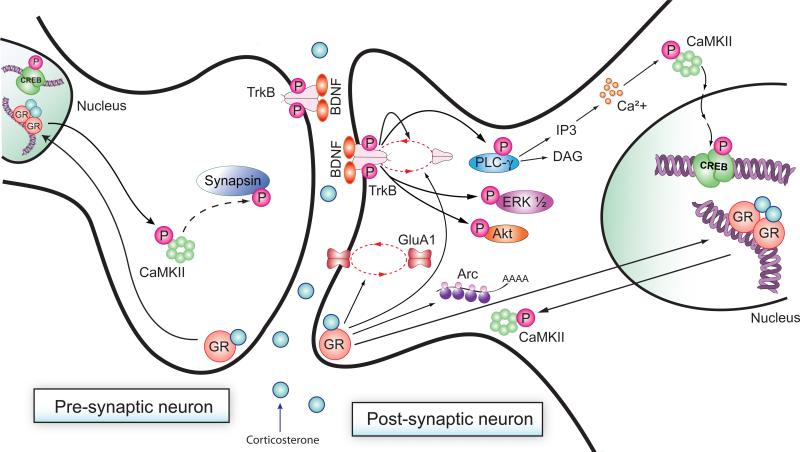Molecular Bases of Memory Formation
Introduction
Molecular neuroscience is an area of chemical neuroscience that studies the molecular basis of intercellular activity applied to animals' nervous systems. This area of research covers molecular neuroanatomy, mechanisms of molecular signaling in the nervous system, and the molecular basis of neuroplasticity and neurodegenerative disease, which we will focus on here.
Stress Mechanisms and Memory Consolidation
Molecular Consolidation via the GR-BDNF-TrkB Pathway
Schematic representation of learning-induced changes in the hippocampus via the GR-BDNF-TrkB pathway:

Image Source: https://www.ncbi.nlm.nih.gov/pmc/articles/PMC4246028/
Here, we will look at learning-induced changes in the hippocampus via the GR-BDNF-TrkB pathway. Specifically, the relation between long-term memory consolidation, stress hormones like glucocorticoids, and glucocorticoid receptors in pre- and post-synaptic neurons. Where GRs mediate several intracellular signaling pathways required for memory consolidation.
Activated GRs may influence traffic of TrkB to the membrane surface and/or BDNF release. The binding of BDNF to its receptor TrkB leads to its phosphorylation. Phosphorylation results in the activation of ERK1/2, Akt and PLC\(\gamma\). Activated GRs affect this and at the same time affect transcription-dependent mechanisms. This parrelel activation rapidly leads to CaMKII\(\alpha\) phosphorylation, similarily to the afforementiond activation of GRs. The activation of ERK1/2, Akt, PLC\(\gamma\), and CaMKII\(\alpha\) pathways independently or can converge in CREB phosphorylation. CREB phosphorylation then leads to the synthesis of BDNF. The newly synthesized BDNF sustains the activation of the pathways and results in persistent phosphorylation of CREB, CaMKII\(\alpha\). The end of this side of the domino effect leads to the downstream pre-synaptic target of CaMKII\(\alpha\), phosopho-synapsin-1. So, GR activation recruits pre- and post-synaptic mechanisms to mediate memory consolidation.
Memory Reconsolidation
Memory consolidation was thought of as a unitary process that transformed a fragile memory trace into a stable one. However, in research done in the 1960s and in the last 15 years have shown otherwise. Memories that have become insensitive to disruption from specific types of interference have been show that they can become transiently labile when those memories are recalled. This recalled memory must again become stable, which is termed memory reconsolidation. We will further examine and look at the answer provide by the authors with respect to memory reconsolidation.
An important question that naturally arises is what function does memory reconsolidation serve? There are two main hypothese proposed, the first being that reconsolidation serves to strengthen memories. The reasoning is that the phase of temporary fragility of the memory mediates additional consolidation, thus, producing a stronger and longer lasting memory. The second hypothesis postulates that the function of the post-retrieval process allows for the association of new information into the memories of past events. The purpose of this being the intergration of new learning with already establised and reactivated memories. More succenctly, the former hypothesis posits the function of memory reconsolidation is to strengthen memorires, while the ladder suggests reconsolidation is for memory updating.
The findings of the researchers in the paper are that reconsolidation strengthens memories and does not mediate in memory updating.
Treatment Approaches via the GR-BDNF-TrkB pathway
The authors mention that it may be possible to target the mechanisms of consolidation in order to block or reduce the formation of very intense, persistent memories, like those associated with PTSD. They mention further that more easily targeted mechanisms would be the reconsolidation of memory retrieval. Given a combination of behavioral or psychotherapeutical approaches combined with pharmacology, it is suggested in the paper that it might be possible to weaken traumatic memories, or through memory consolidation and reconsolidation, possinle to re-store the memory with different emotional valence and intensity.
CaMKII\(\alpha\), BDNF-CREB pathways and Glucocorticoid Receptors
To continue.